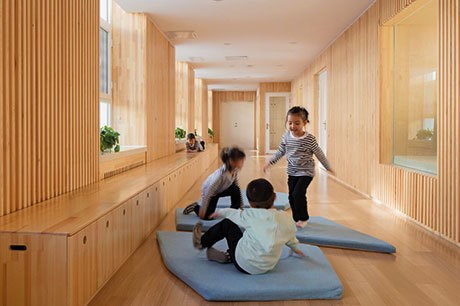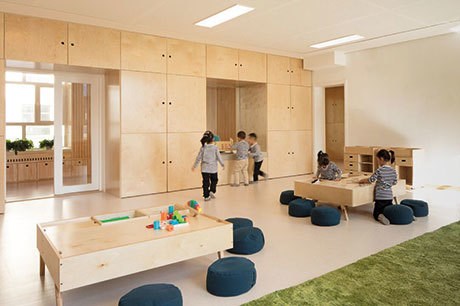Finland approach goes global after China launch
Monday, January 22, 2018
A company teaching early years professionals to implement Finland’s educational ideology and curriculum is looking to expand its model across the world.

A company teaching early years professionals to implement Finland’s educational ideology and curriculum is looking to expand its model across the world.
Helsinki International (HEI) Schools opened its first setting based on the Finnish pre-school approach in Baotou, China (see Case study) in September 2017. Further settings are to follow later this year in Guangzhou, China and Sydney, Australia, with potential expansion into the USA, Europe and the Gulf in 2019.
HEI Schools was co-founded by former Finnish state secretary for education Pilvi Torsti and University of Helsinki professor of education Lasse Lipponen, alongside brand and marketing strategist Milla Kokko and design specialist Anne Rusanen, who wanted to capitalise on international recognition of the results achieved by the Finnish early years education system.
Finland has not ranked outside the top 20 in any discipline measured by the Programme for International Student Assessment (PISA) since the study’s creation in 2000, and came fifth overall and second in Europe in the most recent Progress in International Reading Literacy Study (PIRLS) (see www.nurseryworld.co.uk/nursery-world/news/1163026/england-joint-eighth-in-global-reading-study).
The HEI Schools approach focuses on phenomenon-based learning and the belief that the most intensive learning happens through free play. With the University of Helsinki as a shareholder, the company is able to develop and test its pedagogical model with the support of education academics.
Ms Kokko, chief executive of HEI Schools, said, ‘The Finnish model involves less ranking, less competition and fewer stressful elements for children than many others. We use more encouragement, creativity and free play but without sacrificing academic learning results. We know from research that a play-based model works better for achieving academic results than a super-competitive environment.
‘There has been an increasing interest in adopting the unique schooling system outside of Finland, and we are replying to this request. We are offering the Finnish model as a holistic concept: not only the curriculum, the idea of learning by doing, or the teacher training, but also the experience of Nordic design that is so closely tied to the pedagogical approach.’
HEI Schools provides five ‘Lego blocks’ to early years organisations looking to adopt the Finnish education model:
- Curriculum materials – teacher’s guidebook, lesson plans, video tutorials, learning cards.
- Teacher training – face-to-face introduction sessions, continuous training models via a pathwright.com account, co-teaching period with Finnish teacher on-site, workshops, seminars, events.
- Learning environment – architect designs and floor plans based on Nordic architecture and design.
- Learning materials – digital and analogue materials supporting HEI pedagogy, access to an online store for learning materials and interior design items.
- Operational support – licensing process, quality assurance and control, brand design and marketing support, management and leadership models, consultancy.
Ms Kokko said the key to the HEI Schools approach was to root all aspects of a setting in Finnish educational principles. ‘A beautiful space often has no link to pedagogy, or the other way round,’ she explained. ‘The people planning the physical space or objects work on a completely different team to the teachers. However, we believe the design of the environment and learning materials, as well as the design of the working day, should all be deeply linked to the pedagogics. That is what we feel is truly groundbreaking about our approach.’
HEI Schools invites children to sit in on workshops with designers and teachers to participate in the development of their own environment. Ms Kokko described one session in which children suggested they wanted to stand inside tables as well as on them, so designers created a table with a removable platform that doubled up as a blackboard surface for mark-making.
‘We work on the theory that when an architect designs a home, it is a space, but when you move your own things in, it becomes a place,’ Ms Kokko explained. ‘Adults can provide the nursery space, but children should have the freedom to make it their own place. This process is educational and fun, and we end up with things we would never have thought of which could not have been realised without the children’s help.’
HEI Schools is particularly keen to work with UK-based settings in the future. Ms Kokko said, ‘The UK has a long history of high-quality education, but in some ways it is perhaps a hostage of this history. It would be very interesting to see, if we combined the great history of the UK as an educational superpower with Finland’s younger but undeniably forward-looking and progressive approach, whether we could create something really new, with great results.’
CASE STUDY: HEI IN CHINA

The HEI School in Baotou provides an education for 300 children aged between three and six years old. The kindergarten, which is owned by the City of Baotou, signed a contract with HEI Schools in March 2017. A team of Finnish architects and designers started work on the 4,500 square metre kindergarten immediately, and construction work started in June.
While the setting underwent a complete renovation, 10 Chinese staff members attended a five-week training programme in Finland with five Finnish practitioners (after this pilot project, HEI Schools aims to reduce this to two Finnish professionals). The nursery opened in September 2017, with the Finnish practitioners working alongside their Chinese counterparts in the setting for the first 18 months (reducing to between two and three months in subsequent projects). HEI Schools will then continue to provide support to the Chinese staff via online seminars and lessons and the nursery will function bilingually, with English as its second language.

Ms Kokko said, ‘The Chinese working model is more hierarchical than in Finland, so one of the challenges was prototyping a working culture in which teachers planned by themselves. This ended up being very empowering for the teachers.
‘The Chinese educational model is also very traditional, with lessons in certain subjects. Applying the Finnish system of learning science, for example, through dinosaurs, princesses, tree climbing or eating, not just in a classroom with the teacher speaking, was a very new method for them, but it translated very well.’
- Nursery World is running a trip for early years professionals to Finland and Sweden from 10-17 February 2018, offering a range of cultural excursions alongside visits to pre-school settings to illuminate the ways the countries are supporting early learning. Or visit Peru from 27 May-7 June.




